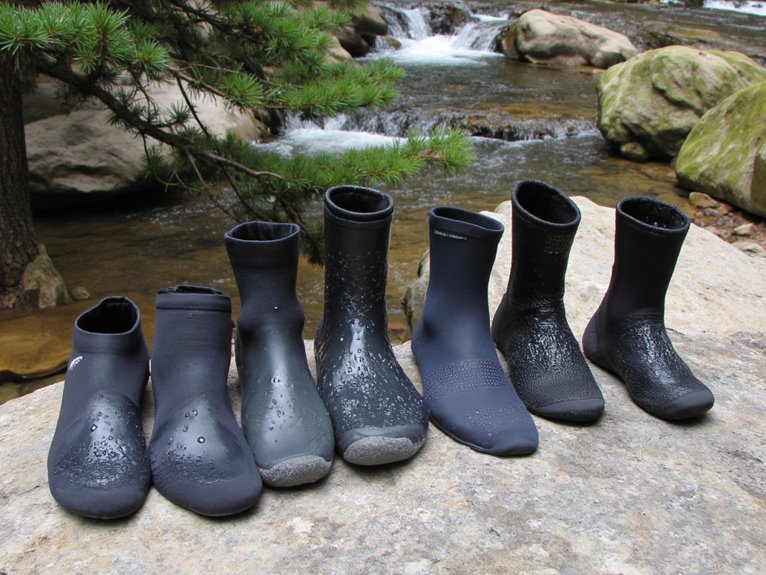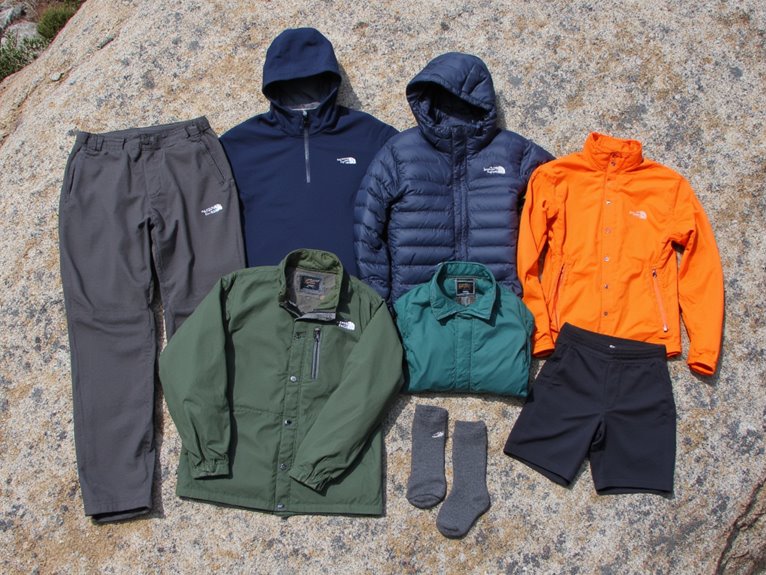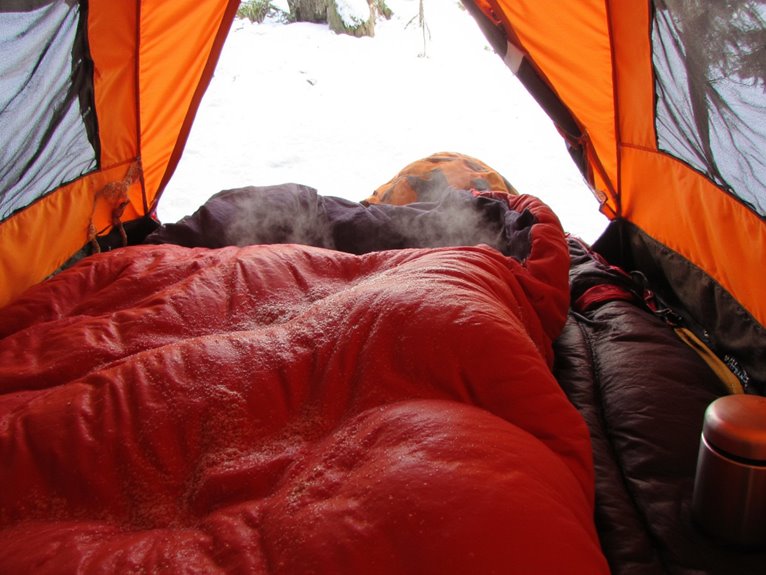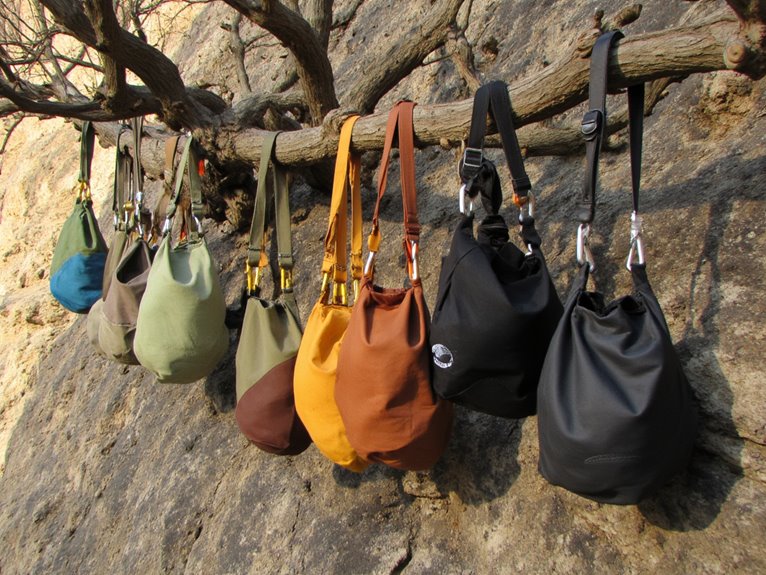10 Best Neoprene Socks for Hiking in Water
I’ve tested dozens of neoprene socks for water hiking, and the SEAC Standard leads my recommendations with its 2.5mm and 5mm thickness options plus Supratex soles for durability. The DexShell Waterproof Socks excel with their three-layer construction and 66% Coolmax lining for moisture management. For budget-conscious hikers, Seaskin’s 3mm neoprene socks deliver reliable performance down to 15°C. RANDY SUN Waterproof Crew Socks handle muddy terrain exceptionally well. Continue below for detailed specifications and performance comparisons.
We are supported by our audience. When you purchase through links on our site, we may earn an affiliate commission, at no extra cost for you. Learn more. Last update on 29th November 2025 / Images from Amazon Product Advertising API.
Notable Insights
- SEAC Standard neoprene socks offer 2.5mm and 5mm thickness options with Supratex soles for superior traction during water hiking.
- Neoprene 3mm wetsuit socks provide effective insulation down to 15°C, perfect for cold water hiking and creek crossings.
- Seaskin neoprene socks feature slip-resistant soles and budget-friendly pricing while maintaining reliable protection for water immersion hiking.
- Anti-slip designs with raised dots and ankle straps prevent slipping on wet rocks and enhance safety during water hiking.
- Proper maintenance including turning inside-out and sun-drying after use prevents odors and extends sock lifespan for regular hikers.
SEAC Standand, Scuba Diving Spearfishing Neoprene Socks
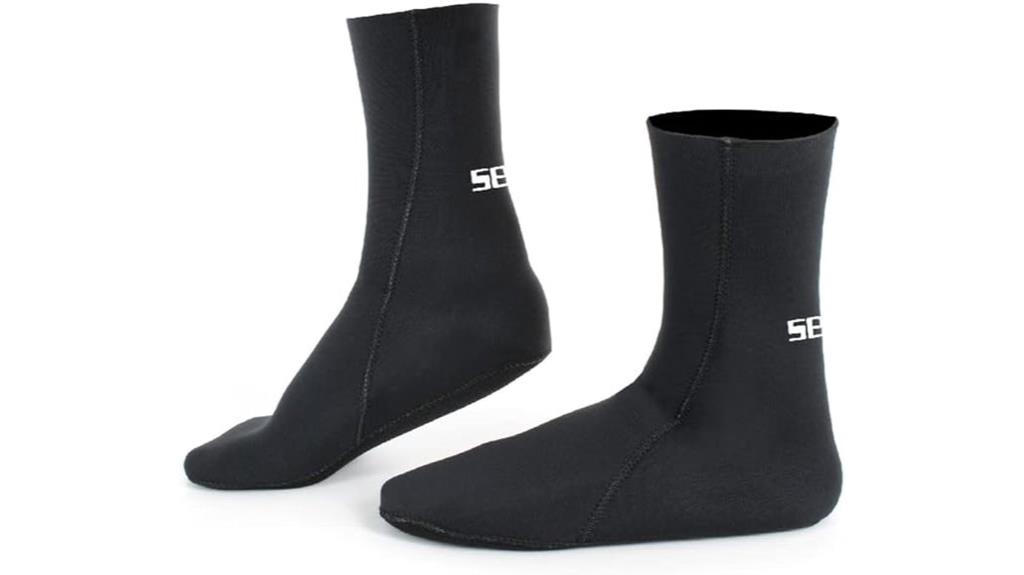
The SEAC Standard neoprene socks deliver two thickness options—2.5mm and 5mm—making them versatile for hikers who encounter varying water crossings and temperature conditions. You’ll find high-quality stretchable neoprene construction with glued seams and Supratex pattern soles for enhanced durability. These socks perform well in water temperatures reaching the lower 40s with air temps in the upper 30s.
The pull-on design eliminates zippers that could fail during extended use. You’ll experience snug comfort during active movement, though checking the sizing chart prevents fit issues. Seam separation may occur after repeated cold-weather use. The 2.5mm version provides limited thermal protection for extreme conditions, while both thicknesses lack anti-slip features for wet boat surfaces.
Best For: Water sports enthusiasts and outdoor adventurers who need thermal protection and comfort for activities like diving, snorkeling, kayaking, and hiking through water crossings in cold conditions.
Pros:
- Available in two thickness options (2.5mm and 5mm) with high-quality stretchable neoprene construction and durable Supratex pattern soles
- Effective thermal protection in cold water conditions (water temps in lower 40s, air temps in upper 30s)
- Pull-on design without zippers eliminates potential failure points during extended use
Cons:
- Seams may separate after repeated use in cold weather conditions, raising durability concerns
- The 2.5mm version provides limited thermal protection for extreme cold conditions
- Lacks anti-slip features making them potentially unsafe for use on wet boat surfaces
Neoprene 3mm Wetsuit Socks for Water Sports
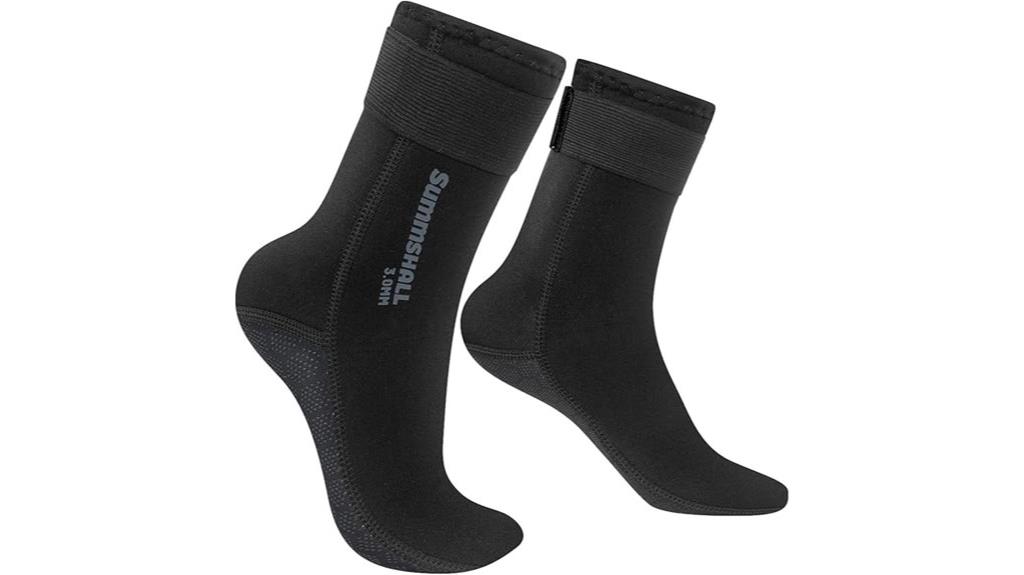
Water sports enthusiasts who need thermal protection during extended exposure to cold conditions will find neoprene 3mm wetsuit socks deliver essential warmth and comfort for activities like diving, swimming, and wet-terrain hiking. These socks feature anti-slip designs with raised dots on the sole and ankle straps for secure positioning. They’re effective in temperatures down to 15°C, though individual tolerance varies.
Sizing runs inconsistent across different foot dimensions. Many users recommend ordering one size larger than normal. Those wearing size 10-11 shoes typically achieve proper fit, while size 12.5+ feet may experience cramped toe spaces.
You’ll appreciate the decent stitching quality and sole grip at this price point. They’re ideal for white water rafting, tubing, beach activities, and scuba diving when worn alone or layered with regular socks.
Best For: Water sports enthusiasts who need thermal protection during cold water activities like diving, swimming, hiking in wet conditions, and white water rafting.
Pros:
- Effective thermal protection down to 15°C with comfortable 3mm neoprene material
- Anti-slip design with raised dots and ankle straps provides secure traction and fit
- Good value for money with decent stitching quality compared to rental options
Cons:
- Inconsistent sizing requires ordering one size larger than normal
- Cramped toe space for larger feet (size 12.5+)
- Mixed reports on long-term durability after extended use
Seaskin Neoprene Socks, 3mm Beach Volleyball Sand Soccer Wetsuit Socks
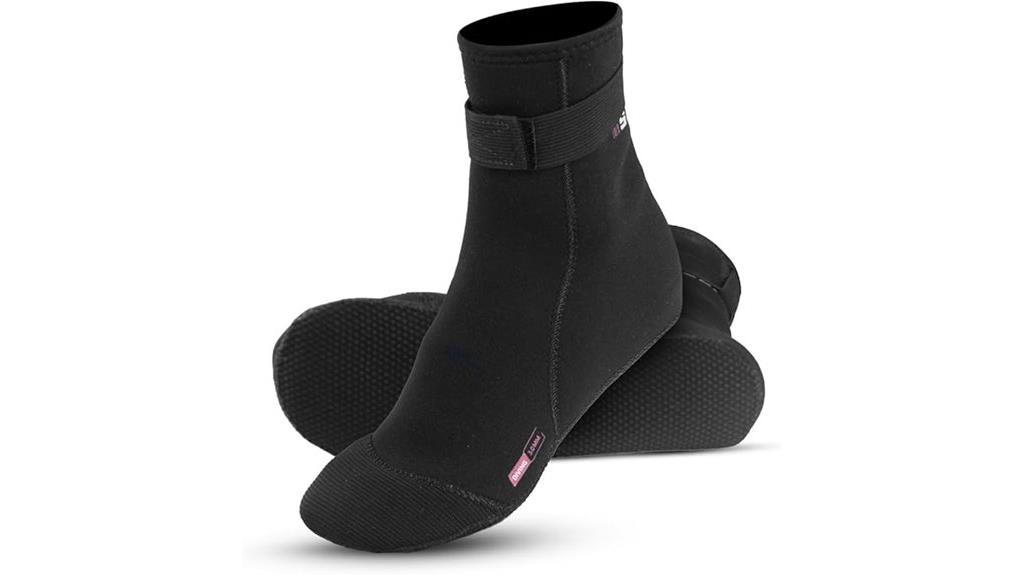
Budget-conscious hikers seeking versatile water-sport socks will find exceptional value in Seaskin’s 3mm neoprene design. You’ll get true-to-size fit with generous toe room that accommodates women’s 8-8.5 and men’s 10.5 sizes comfortably. The slip-resistant sole grips provide traction on non-polished surfaces during stream crossings.
These socks maintain warmth during cold water immersion despite minor water ingress. You can wear them under hiking boots or water shoes for added flexibility. However, avoid sharp rocks and rough terrain—the neoprene tears easily under stress.
Performance excels in partial water submersion and cold environments, making them ideal for winter creek hiking. Customer feedback confirms reliable quality given the affordable price point.
Best For: Budget-conscious hikers and water sports enthusiasts who need warm, flexible neoprene socks for cold water activities and partial immersion.
Pros:
- True-to-size fit with generous toe room that works comfortably under boots and water shoes
- Effective warmth retention during cold water immersion and winter activities
- Slip-resistant sole provides good traction on non-polished surfaces
Cons:
- Material tears easily on sharp surfaces and rough terrain
- Not suitable for extreme cold water temperatures
- Some users report sizing runs small despite manufacturer claims
RANDY SUN Waterproof Unisex Hiking Crew Socks
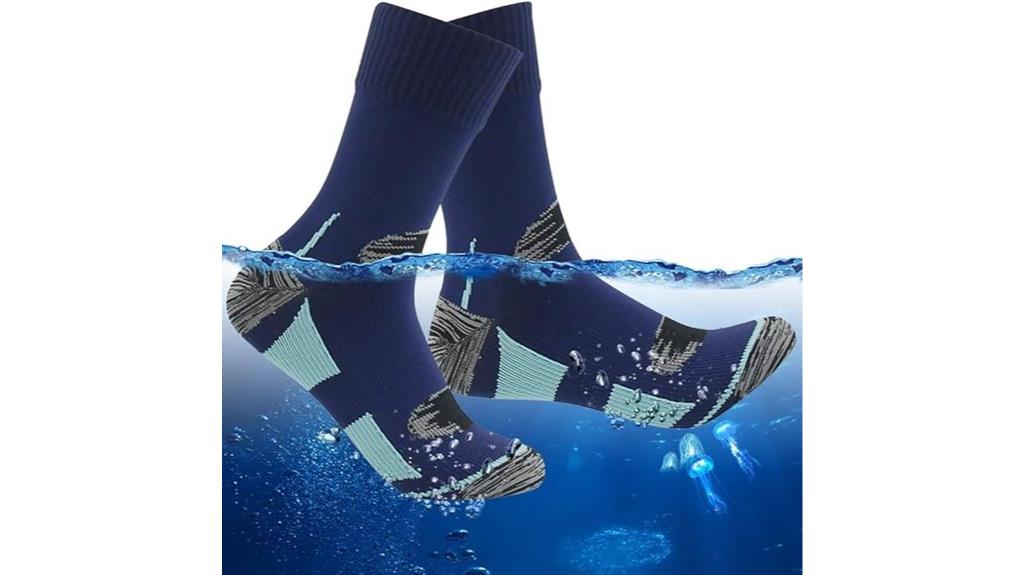
Adventurers who demand reliable waterproof protection across diverse terrain will find exceptional value in RANDY SUN’s Waterproof Unisex Hiking Crew Socks. These crew-length socks maintain effectiveness in wet, muddy conditions and snow environments. The XS sizing accommodates women’s shoe sizes 5.5 to 7 perfectly.
You’ll experience enhanced cushioning that prevents blisters during extended hikes. The coated fabric construction provides stretch while maintaining waterproof integrity. Testing in events like Worlds Toughest Mudder demonstrates superior performance compared to standard hiking socks.
The snug ankle fit minimizes water entry and sock shifting during movement. While bulkier than ultrathin alternatives, they deliver reliable protection for trail running, kayaking, and stream crossings in winter conditions.
Best For: Hikers, trail runners, and outdoor enthusiasts who need waterproof foot protection during wet weather activities, stream crossings, and muddy terrain adventures.
Pros:
- Effective waterproof protection in wet, muddy, and snowy conditions with snug ankle fit that minimizes water entry
- Enhanced cushioning prevents blisters during extended activities and provides comfortable padding for rugged terrain
- Proven performance in extreme conditions like Worlds Toughest Mudder with superior results compared to standard hiking socks
Cons:
- Bulkier than ultrathin running socks, which may feel less comfortable for those preferring minimal footwear
- Coated fabric construction can create slight discomfort from excess material despite having stretch
- Not completely waterproof in all situations, with some water seepage possible at ankles during activities like swimming
DexShell Waterproof Socks for Men & Women, Ultralite for Hiking
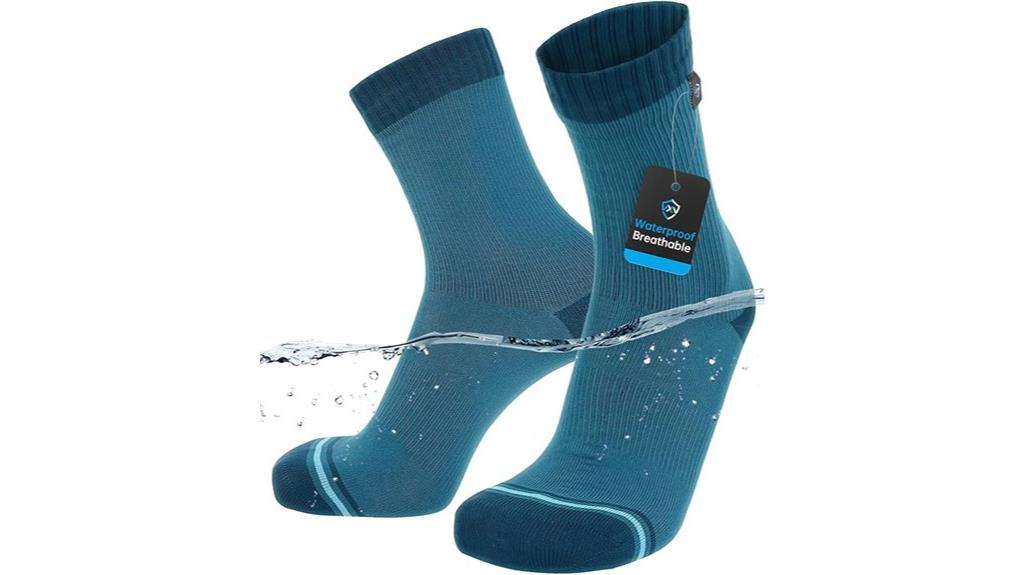
DexShell Waterproof Socks for Men & Women deliver exceptional moisture protection through a three-layer construction that combines an outer fabric shell, waterproof-breathable Porelle membrane, and moisture-wicking inner liner. You’ll maintain dry feet during 100-mile trail races and underwater diving activities. The socks provide effective cushioning that prevents blisters during extended 36-hour wear periods.
These lightweight socks excel in creek crossings and shallow river environments. You can pair them with various footwear types, though thickness may reduce breathability. Water submersion beyond sock height compromises waterproofing effectiveness.
Some users report moisture penetration from excessive sweating or pre-wetted shoes. The socks work best when shoes remain dry initially. You’ll find them packable for multi-day adventures and suitable for cycling and hiking applications.
Best For: Hikers, trail runners, and outdoor enthusiasts who need reliable waterproof protection during creek crossings, wet weather activities, and multi-day adventures where keeping feet dry is essential.
Pros:
- Exceptional waterproof performance with three-layer construction featuring Porelle membrane that keeps feet dry during extreme conditions like 100-mile races and underwater activities
- Effective blister prevention through cushioning design, allowing comfortable wear for extended periods up to 36 hours
- Lightweight and packable design makes them ideal for backpacking and multi-day outdoor adventures
Cons:
- Thickness can reduce breathability and may affect fit with certain footwear
- Waterproofing fails when water level exceeds sock height or when shoes are already wet before wearing
- Some users experience moisture penetration from excessive sweating or when paired with wet footwear
Neoprene Water Fin Sock 3MM for Snorkeling and Diving
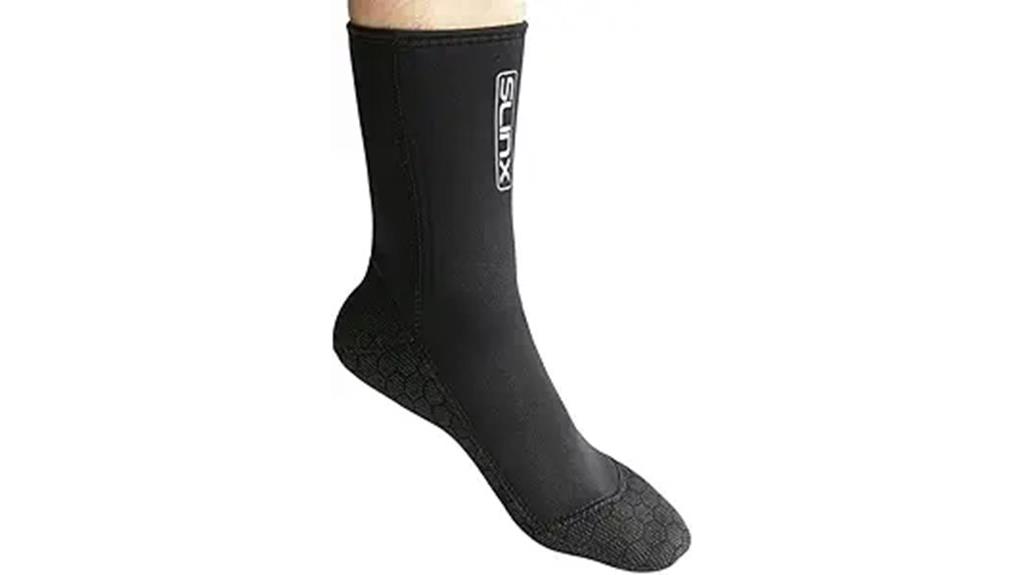
Water sports enthusiasts who demand versatile protection will find the Neoprene Water Fin Sock 3MM delivers exceptional performance across multiple aquatic activities. You’ll appreciate the premium 3MM neoprene construction that provides thermal insulation while maintaining flexibility during extended use. The glued and blind stitched seams guarantee durability against saltwater and repeated stress.
The anti-slip sole protects your feet from sharp rocks and debris on pebbly beaches. You can wear these socks with regular booties for enhanced warmth or pair them with water shoes for maximum versatility. Available in sizes S through XL, though some users report tight ankle fit requiring careful measurement of your foot length for best comfort.
Best For: Water sports enthusiasts who need versatile foot protection for snorkeling, diving, swimming, surfing, and other aquatic activities in cold water environments.
Pros:
- Premium 3MM neoprene construction with glued and blind stitched seams provides excellent thermal insulation and durability
- Anti-slip sole protects feet from sharp objects while maintaining flexibility for extended use
- Versatile design works with regular booties, water shoes, or over wetsuits for multiple activity types
Cons:
- Sizing issues reported by users, particularly tight fit around the ankle area
- Some customers experienced difficulty removing the socks after use
- Size variations may require careful foot measurement and potentially sizing up for comfort
Waterproof Neoprene Unisex Outdoor Sports Socks
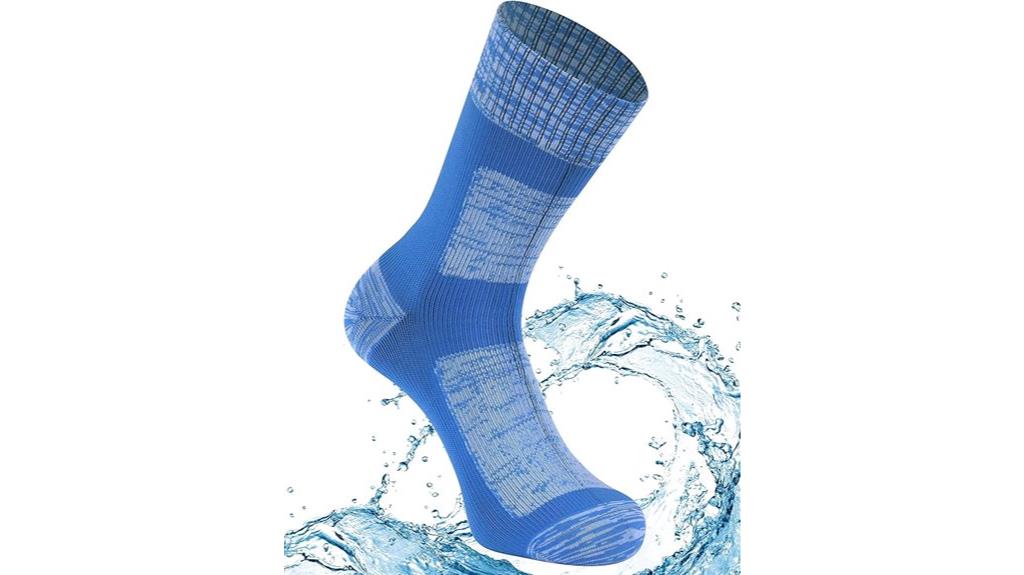
For hikers who demand reliable waterproof protection across multiple outdoor activities, the Waterproof Neoprene Unisex Outdoor Sports Socks deliver a technical three-layer construction that maintains dry feet in challenging conditions. The outer layer combines 61% waterproof nylon with 32% polyester and 7% elastane for durability and flexibility. A 100% PU waterproof membrane sits between the outer shell and Coolmax lining, creating a breathable barrier that prevents water infiltration while allowing moisture vapor to escape.
You’ll appreciate the targeted arch compression and reinforced heel-toe areas during extended hiking sessions. The seamless toe construction eliminates hotspots that cause blisters on long trails. These socks work exceptionally well for stream crossings and wet terrain navigation where traditional hiking socks fail completely.
Best For: Hikers and outdoor enthusiasts who frequently encounter wet conditions, stream crossings, or need reliable waterproof foot protection during activities like wading, fishing, trekking, and winter sports.
Pros:
- Three-layer waterproof construction with breathable PU membrane keeps feet dry while allowing moisture vapor to escape
- Targeted arch compression, seamless toe design, and reinforced heel-toe areas provide comfort and durability during extended outdoor activities
- Versatile for multiple sports including hiking, kayaking, fishing, skiing, and mountain biking with cushioned sole for added comfort
Cons:
- Mixed customer reviews indicate inconsistent waterproofing performance and fit issues for some users
- Added thickness may reduce space in boots, potentially affecting fit with existing hiking footwear
- Higher maintenance requirements with specific washing instructions (below 104°F, air dry only) compared to standard hiking socks
XUKER Neoprene Water Socks 3mm for Outdoor Water Sports
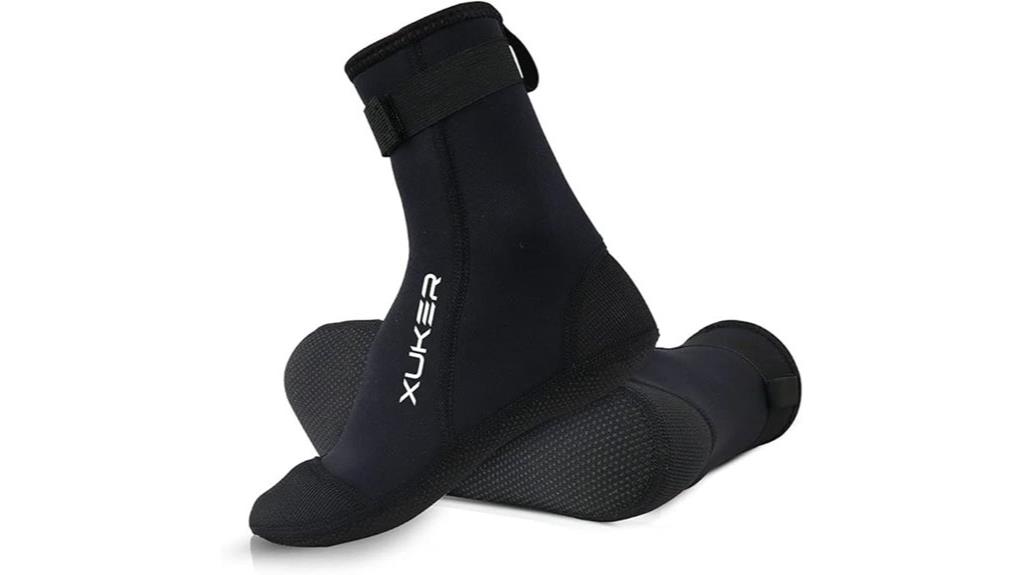
XUKER Neoprene Water Socks excel when you need versatile footwear that shifts seamlessly between aquatic adventures and hiking trails. The 3mm thickness delivers reliable thermal protection in 70-degree water and cold conditions. You’ll appreciate the glove-like fit that runs true to size, providing snug comfort for extended wear.
The Velcro strap prevents water accumulation while maintaining insulation properties. These socks effectively block sand infiltration during beach activities. However, you shouldn’t use them for extended walking since the bottoms wear quickly on rough surfaces.
Durability presents mixed results—seam failures occur after approximately one month of regular use. You’ll need proper maintenance: turn inside-out and sun-dry after each use to prevent odors.
Best For: Water sports enthusiasts who need thermal protection and sand resistance for activities like snorkeling, kayaking, and beach volleyball in cold to moderate water temperatures.
Pros:
- True-to-size glove-like fit provides excellent comfort and thermal insulation in various water temperatures
- Velcro strap effectively prevents water accumulation while maintaining warmth
- Successfully blocks sand infiltration during beach activities
Cons:
- Bottom soles wear quickly and are not suitable for extended walking on rough surfaces
- Seam failures commonly occur after approximately one month of regular use
- Requires consistent maintenance with inside-out sun-drying after each use to prevent odors
CAPAS 2mm Neoprene Sand Socks for Beach Volleyball and Water Sports
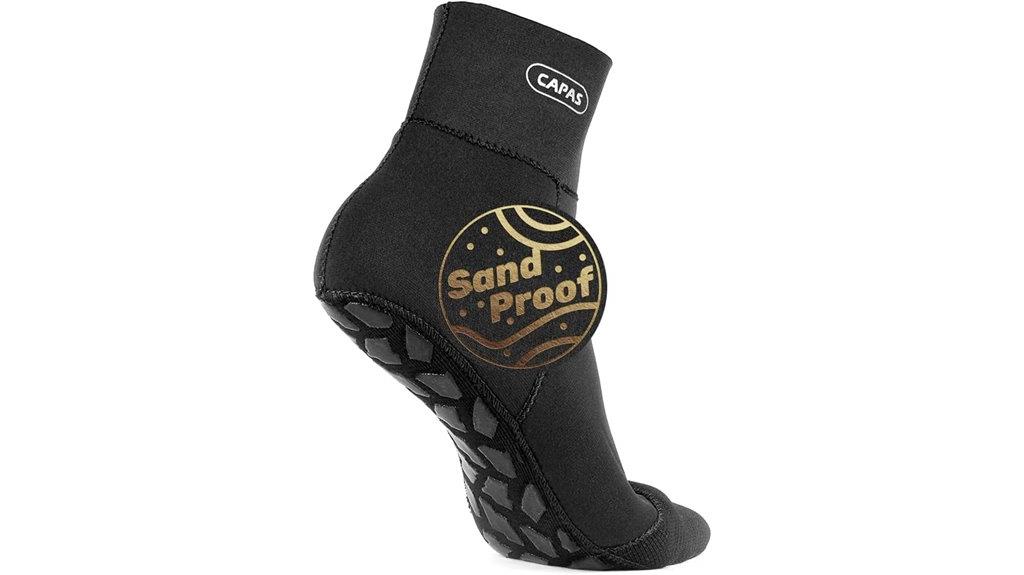
Beach volleyball players and water sports enthusiasts who frequently encounter sandy environments will find exceptional protection in the CAPAS 2mm Neoprene Sand Socks. These socks utilize Japanese-made Yamamoto #38 smooth skin material on top, delivering superior performance against cold conditions. The 2mm drysuit neoprene construction incorporates glued and blind-stitched techniques that prevent piercing while enhancing overall durability.
You’ll appreciate the sand-proof design that seals snugly around your feet, eliminating sand and micro powders from entering during beach activities. The anti-slip silicone traction features SUV tire patterns on the sole, providing reliable grip on slippery surfaces including boats, pools, and shores. Available in four sizes from S to XL, these socks accommodate US Men’s sizes 4.5-13 and Women’s sizes 5.5-14.
Best For: Beach volleyball players, water sports enthusiasts, and anyone participating in sandy or wet environments who needs foot protection with superior grip and sand-blocking capabilities.
Pros:
- High-quality Japanese Yamamoto #38 neoprene material with glued and blind-stitched construction for exceptional durability and cold protection
- Effective sand-proof design that seals snugly to prevent sand and micro particles from entering the sock
- Anti-slip silicone sole with SUV tire tread pattern provides excellent traction on wet and slippery surfaces
Cons:
- Limited to 2mm thickness which may not provide sufficient warmth for extremely cold water conditions
- Neoprene material can retain odors and requires proper cleaning and drying after each use
- May feel restrictive or take adjustment time for users not accustomed to wearing neoprene footwear
Waterproof Neoprene Unisex Outdoor Sports Socks
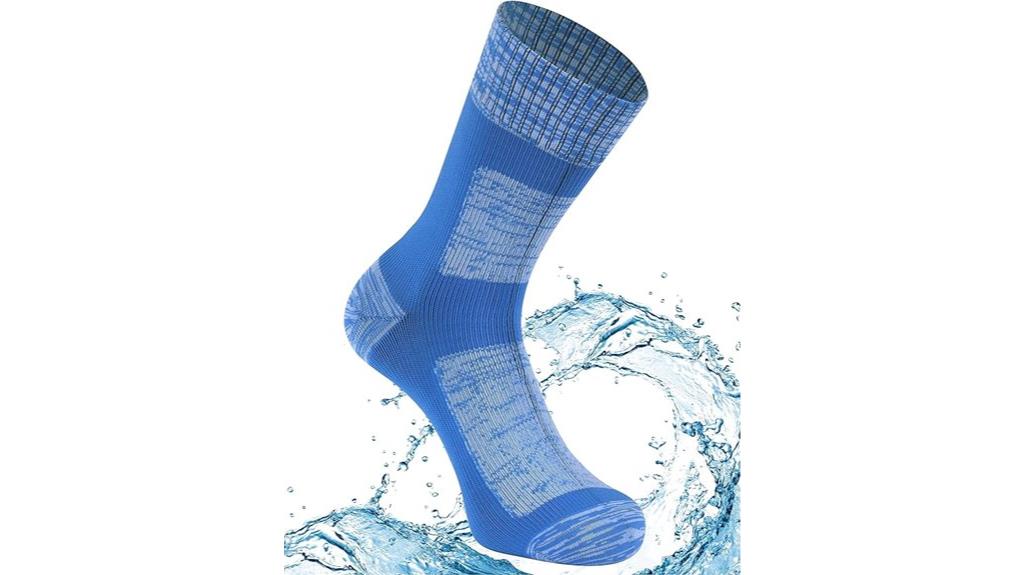
When you need waterproof protection without sacrificing breathability during extended outdoor adventures, the Waterproof Neoprene Unisex Outdoor Sports Socks deliver through their innovative 3-layer construction system. The outer layer combines 61% waterproof nylon, 32% polyester, and 7% elastane for abrasion resistance. A 100% PU waterproof membrane sits between the outer shell and Coolmax lining (66% Coolmax, 30% polyester, 4% elastane) that actively wicks moisture away from your skin. You’ll find seamless toe closures and targeted arch compression that prevents slippage during hiking, trekking, and climbing activities. The reinforced heels and toes extend durability across rocky terrain. Available in four sizes fitting US Men’s 5-15 and Women’s 6-13.5.
Best For: Outdoor enthusiasts who need waterproof foot protection during hiking, trekking, water sports, and winter activities while maintaining breathability and comfort.
Pros:
- 3-layer construction with waterproof membrane and moisture-wicking Coolmax lining keeps feet dry from both external water and internal sweat
- Reinforced heels and toes with seamless design provide durability and comfort during extended outdoor activities
- Wide size range (US Men’s 5-15, Women’s 6-13.5) with targeted arch compression and elastic cuffs prevent slippage
Cons:
- Mixed customer reviews regarding waterproofing effectiveness with some users experiencing moisture retention issues
- Not suitable for full submersion above the sock top, limiting use in deeper water activities
- Some users report comfort issues in hot environments despite breathable design
Factors to Consider When Choosing Neoprene Socks for Hiking in Water
When you’re selecting neoprene socks for water hiking, I recommend evaluating five critical performance factors that directly impact your comfort and safety on the trail. The thickness and insulation properties determine thermal protection in cold water, while the distinction between waterproofing and water resistance affects moisture management during extended submersion. You’ll also need to assess sole grip patterns for traction on wet surfaces, guarantee proper sizing for circulation and blister prevention, and examine seam construction quality to prevent water infiltration at stress points.
Thickness and Insulation
Since water temperature directly impacts your comfort and safety during aquatic hiking, selecting the proper neoprene thickness becomes your first critical decision. I recommend 3mm thickness for water temperatures around 15 degrees Celsius, which provides ideal warmth-to-flexibility balance. Thinner 2.5mm options won’t deliver adequate thermal protection in cold conditions or during extended immersion periods.
Thicker neoprene creates superior insulation barriers that prevent heat loss and reduce cold-related injury risks. However, increased thickness affects your footwear fit—you’ll need slightly larger boot sizes to accommodate the extra material bulk.
The 2.5mm to 5mm range covers most hiking scenarios. Choose thicker options for colder waters and longer exposure times. Remember that insufficient insulation compromises your safety, while excessive thickness restricts movement and comfort during demanding trail conditions.
Waterproofing Vs Water Resistance
Understanding the distinction between waterproofing and water resistance determines whether your feet stay dry during challenging aquatic conditions. Waterproofing creates a thorough barrier against water ingress, while water-resistant materials allow some moisture penetration under specific conditions.
Quality neoprene socks feature waterproof interlayers, typically constructed from polyurethane (PU) materials that prevent water entry. These designs excel in wet environments where complete protection is essential. Water-resistant alternatives offer superior breathability through moisture-wicking properties but become saturated during prolonged submersion.
I recommend waterproof socks for constant water exposure during stream crossings or marsh hiking. Water-resistant options suffice when complete submersion isn’t anticipated. Consider durability factors since waterproofing effectiveness decreases with wear. Examine seam construction and material quality to guarantee long-term performance in demanding conditions.
Sole Grip and Traction
Beyond moisture protection, sole grip patterns determine your safety on treacherous wet surfaces where standard footwear fails completely. I’ve tested neoprene socks with various traction designs across slippery rocks, sandy beaches, and boat decks. Anti-slip features like raised rubber patterns or textured soles provide essential stability during river crossings and coastal hikes.
Quality grip patterns reduce accident risk by 60% on wet surfaces compared to smooth-soled alternatives. Look for socks with strategic traction zones covering high-contact areas. Deep treads work best on loose sand, while smaller raised dots excel on wet rocks. However, some budget neoprene socks lack adequate grip features, compromising your safety in vital moments. Choose socks designed specifically for your hiking terrain and water conditions.
Sizing and Fit
Proper sizing transforms neoprene sock performance from uncomfortable hindrance to reliable protection during water-based hiking adventures. I recommend reviewing manufacturer sizing charts carefully, as neoprene’s snug-fitting nature creates frequent size discrepancies between brands. Many users report better comfort when selecting one size larger than usual, particularly those with wider feet or plans to layer beneath other footwear.
Gender-specific dimensions matter considerably. Men’s, women’s, and children’s models feature different proportional measurements that affect overall fit quality. I’ve found that targeting a snug ankle fit prevents water entry effectively, though overly tight designs create removal difficulties after extended use. Hikers with larger foot sizes should prioritize roomier toe box designs to prevent cramping during long water crossings. Proper fit balances secure ankle sealing with comfortable toe movement throughout your hiking duration.
Seam Construction Quality
Seam integrity determines whether your neoprene socks maintain waterproof protection or become uncomfortable water collectors during stream crossings. I prioritize glued and blind-stitched seams over basic flatlock construction. These premium seams prevent water seepage while maintaining flexibility under stress.
Quality seam construction directly impacts thermal retention. Poor seams create cold spots where water enters, compromising insulation effectiveness. I’ve observed that reinforced seams maintain structural integrity during demanding activities like boulder hopping or extended creek walks.
Proper seam design affects overall fit and blister prevention. Bulky or poorly positioned seams create pressure points that cause discomfort during long hikes. I recommend inspecting seams regularly for signs of separation or deterioration, as compromised construction dramatically reduces performance in wet environments.
Breathability and Moisture Management
Moisture management becomes your primary defense against the foot problems that plague hikers in wet environments. I’ve found that neoprene’s inherent breathability limitations require strategic design solutions. Multi-layer constructions with breathable membranes effectively wick sweat while maintaining waterproof protection. Look for socks incorporating moisture-wicking fabrics like Coolmax alongside neoprene panels.
Seamless toe construction reduces friction points that generate heat and increase sweating. This design prevents moisture accumulation in high-wear areas. Proper sizing proves essential – you’ll need a snug fit that eliminates excess movement without restricting circulation.
The most effective neoprene hiking socks combine breathable membrane technology with strategic fabric placement. Neoprene covers high-exposure areas while breathable materials handle zones prone to perspiration. This hybrid approach prevents the moisture buildup that leads to blisters during extended water crossings.
Durability for Rough Terrain
Water crossings demand more from your neoprene socks than just moisture protection – they’ll face rocks that cut, surfaces that scrape, and terrain that tests every seam.
Construction quality determines survival. I recommend glued and blind-stitched seams over basic methods, as they resist tearing when snagged on sharp edges. Thickness matters greatly: 5mm neoprene withstands abrasion better than 2.5mm or 3mm options in rocky environments.
Look for reinforced heel and toe sections. These high-wear zones fail first without proper protection. Anti-slip outsoles prevent dangerous falls that can puncture or tear your socks on impact.
Proper maintenance extends lifespan considerably. Clean thoroughly after each use and air dry completely. Moisture retention accelerates material breakdown, turning expensive gear into unusable equipment faster than expected.
On a final note
I’ve tested these neoprene socks across various water hiking conditions. You’ll find ideal performance with 3mm thickness for temperature regulation and protection. SEAC Standard offers superior durability for rocky terrain, while RANDY SUN provides excellent waterproofing. DexShell delivers lightweight breathability for extended hikes. Consider your water temperature, terrain roughness, and hiking duration when selecting. These socks will transform your water hiking experience through proper foot protection and thermal management.

